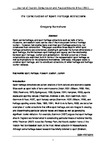The Construction of Sport Heritage Attractions
| dc.contributor.author | Ramshaw, G. | |
| dc.date.accessioned | 2018-05-17T12:46:23Z | |
| dc.date.accessioned | 2018-05-24T10:32:16Z | |
| dc.date.available | 2018-05-17T12:46:23Z | |
| dc.date.available | 2018-05-24T10:32:16Z | |
| dc.date.issued | 2011 | |
| dc.identifier.citation |
Ramshaw, G. (2011) 'The Construction of Sport Heritage Attractions', Journal of Tourism Consumption and Practice, 3(1), pp.1-25 | |
| dc.identifier.issn | 1757-031X | |
| dc.identifier.uri | http://hdl.handle.net/10026.1/11568 | |
| dc.description.abstract |
Sport can be heritage, and sport heritage attractions such as halls of fame, museums, and stadium tours can be one of the more potent forms of heritage tourism. However, few studies have examined sport heritage attractions, nor considered their construction. This paper examines three ways in which sport heritage attractions are constructed, exploring in particular the human dimensions of sport heritage, the link between sport heritage and legacy, and the relationship between sport heritage, tourism and globalization. Several outcomes of these constructions are examined, both in terms of the representation sport heritage as well as implications for the attractions themselves. Ultimately, this paper seeks to consider sport heritage, and its constituent attractions, in wider heritage and heritage tourism debates. | |
| dc.language.iso | en | en_US |
| dc.publisher | University of Plymouth | |
| dc.rights | Attribution 4.0 International (CC BY 4.0) | |
| dc.subject | sport | |
| dc.subject | heritage | |
| dc.subject | museum | |
| dc.subject | stadium | |
| dc.subject | tourism | |
| dc.title | The Construction of Sport Heritage Attractions | en_US |
| dc.type | Article | |
| plymouth.issue | 1 | |
| plymouth.volume | 3 | |
| plymouth.journal | Journal of Tourism Consumption and Practice |


